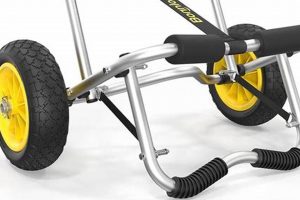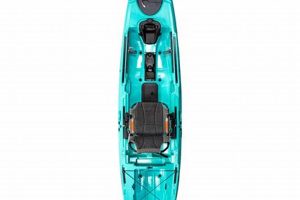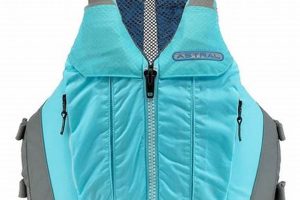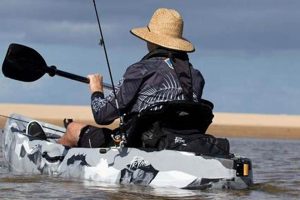This activity combines the quiet, maneuverable nature of kayaks with the abundant fishing opportunities found in the shallow-water ecosystems surrounding the Florida Keys. Anglers utilize specialized kayaks equipped with rod holders, storage compartments, and often fish finders to pursue a variety of species. This method allows for access to areas unreachable by larger vessels, offering a closer connection with the marine environment.
The shallow flats, mangrove forests, and backcountry channels of the Keys provide ideal habitat for numerous sport fish, making this method a highly effective and enjoyable approach. It provides a low-impact way to experience the natural beauty and biodiversity of the region while offering a challenging and rewarding fishing experience. This approach has grown in popularity due to its accessibility and the unique perspective it provides anglers.
Further exploration of this topic will cover essential equipment, popular target species, ideal fishing locations, relevant regulations, safety considerations, and techniques for maximizing success.
Tips for Kayak Fishing in the Florida Keys
Successful excursions require careful planning and preparation. The following tips offer valuable insights for maximizing safety and angling success.
Tip 1: Prioritize Safety Equipment: Always wear a personal flotation device (PFD). Carry a whistle, signaling mirror, and VHF radio. A fully charged mobile phone in a waterproof case is also recommended.
Tip 2: Understand Local Regulations: Obtain the necessary fishing licenses and familiarize oneself with size and catch limits for targeted species. Be aware of any area closures or restricted zones.
Tip 3: Plan for Weather Conditions: Check marine forecasts before departing. Wind, tides, and currents can significantly impact kayak handling and fishing conditions. Postpone trips if conditions are unfavorable.
Tip 4: Choose Appropriate Gear: Select a kayak designed for stability and suitable for fishing. Essential equipment includes rod holders, tackle storage, and an anchor. Consider a fish finder for locating fish and structure.
Tip 5: Pack Essential Supplies: Bring plenty of water, sunscreen, a hat, and polarized sunglasses. A first-aid kit, knife, and multi-tool are also crucial for addressing unforeseen situations.
Tip 6: Practice Kayak Handling: Become comfortable maneuvering the kayak, especially in wind and currents, before venturing into open water. Practice casting and retrieving from a seated position.
Tip 7: Respect the Environment: Practice catch-and-release whenever possible. Properly dispose of all fishing line and trash. Avoid disturbing wildlife and sensitive habitats.
Adhering to these guidelines will enhance both safety and the likelihood of a successful and enjoyable fishing experience.
By incorporating these tips, anglers can contribute to the preservation of this unique ecosystem while enjoying its abundant fishing opportunities.
1. Stable Kayak Selection
Stable kayak selection is paramount for successful kayak fishing in the Florida Keys. The region’s diverse waters, ranging from calm flats to open ocean currents, demand a kayak capable of handling varied conditions. Stability directly impacts an angler’s ability to cast, retrieve, and land fish effectively. A stable platform minimizes the risk of capsizing, especially when battling larger fish or navigating challenging currents. This is crucial for safety and for maintaining focus on fishing. For example, a wider, sit-on-top kayak provides enhanced stability compared to a narrower, sit-inside model, proving more suitable for the often unpredictable conditions encountered in the Keys.
The shallow flats and backcountry areas of the Keys are prime fishing grounds, but often present variable winds and currents. A stable kayak allows anglers to confidently navigate these areas, maximizing fishing time and access to productive spots. Conversely, an unstable kayak can hinder casting accuracy, making it difficult to present lures or bait effectively. It also increases the likelihood of tipping, potentially resulting in lost equipment or even injury. Consider the scenario of hooking a tarpon, a powerful game fish common in the Keys. A stable kayak is essential for managing the fight and successfully landing the fish without compromising angler safety.
Ultimately, selecting a stable kayak platform optimized for the specific fishing conditions encountered in the Florida Keys significantly enhances safety and fishing success. This choice allows anglers to confidently explore diverse environments and focus on the fishing experience, contributing to a more rewarding and enjoyable outing. It also reduces the risk of accidents, preserving both personal well-being and the integrity of the delicate ecosystem.
2. Essential Safety Gear
The unique environment of the Florida Keys presents specific safety considerations for kayak anglers. Open water exposure, strong currents, intense sun, and the potential for sudden weather changes necessitate careful attention to safety gear. A properly outfitted kayak angler prioritizes personal safety, enabling a more focused and enjoyable fishing experience. Neglecting essential safety precautions can lead to dangerous situations, impacting not only the angler but potentially requiring search and rescue operations. For example, a sudden squall can quickly capsize an unprepared kayaker, emphasizing the importance of a readily accessible personal flotation device (PFD).
Essential safety gear extends beyond a PFD. A VHF radio allows direct communication with the Coast Guard and other boaters in case of emergencies. A signaling device, such as a whistle or mirror, aids in attracting attention if assistance is needed. Given the remote nature of some fishing locations, a fully charged mobile phone in a waterproof case provides an additional communication option. Navigation tools, like a GPS device or chart, are crucial for orientation, especially in the intricate channels and flats of the Keys. Sun protection, including sunscreen, a hat, and polarized sunglasses, minimizes the risk of sunburn and heatstroke. Carrying a first-aid kit allows for immediate treatment of minor injuries. These preparations mitigate potential risks and enhance overall safety.
Prioritizing safety gear contributes significantly to a positive and safe kayak fishing experience in the Florida Keys. While focusing on angling success is important, preparedness for unforeseen circumstances ensures a more enjoyable and responsible outing. This proactive approach minimizes potential dangers, reduces the strain on emergency services, and promotes responsible enjoyment of the marine environment. The combination of appropriate safety equipment and a clear understanding of its use allows anglers to confidently navigate the challenges of this unique ecosystem.
3. Effective Fishing Techniques
Effective fishing techniques are crucial for successful kayak fishing in the Florida Keys. The diverse fish species inhabiting these waters require specific approaches. Understanding these nuances maximizes catch rates and enhances the overall fishing experience. Choosing the right technique depends on target species, location, and prevailing conditions.
- Light Tackle and Artificial Lures:
Species like bonefish, tarpon, and permit often respond well to light tackle and artificial lures. Fly fishing is a popular technique employing specialized rods, reels, and artificial flies designed to mimic prey. Spin fishing with lightweight lures, such as jigs and soft plastics, also proves effective. These methods allow for precise presentations and a more active fishing style. Matching lure color and size to prevailing baitfish patterns increases the chance of a successful strike.
- Live Bait Fishing:
Live bait remains a highly effective technique, particularly for targeting larger species like snapper, grouper, and sharks. Shrimp, crabs, and small baitfish are common choices. Positioning the kayak near structure, such as reefs or wrecks, and presenting live bait naturally increases the likelihood of attracting these predatory fish. Using appropriate tackle and rigging ensures the bait is presented effectively at the desired depth.
- Drift Fishing:
Drift fishing allows anglers to cover a wider area, particularly in shallow flats and channels. The kayak drifts with the wind or current, presenting bait or lures to fish along the way. This technique is effective for targeting species like redfish, snook, and sea trout. Adjusting drift speed and direction maximizes coverage of productive areas. Maintaining awareness of surrounding boat traffic and potential hazards is essential while drift fishing.
- Trolling:
Trolling involves dragging lures or bait behind a moving kayak. This technique is especially effective for pelagic species like mackerel, kingfish, and wahoo. Varying trolling speed and lure depth helps locate active fish. Using appropriate tackle and line strength is crucial when targeting larger pelagic species. When trolling in the Keys, it’s essential to be mindful of other vessels and avoid congested areas.
Mastering these techniques significantly enhances kayak fishing success in the Florida Keys. Adapting techniques to specific target species and environmental conditions is crucial. Combining appropriate techniques with knowledge of fish behavior and habitat preferences leads to a more rewarding and productive fishing experience. Furthermore, respecting local regulations and practicing catch-and-release contribute to the sustainability of the fishery and preserve its unique ecosystem for future generations.
4. Respectful Environmental Practices
Respectful environmental practices are integral to sustainable kayak fishing in the Florida Keys. This delicate ecosystem supports a diverse range of marine life and habitats, susceptible to disruption from human activity. Kayak fishing, due to its close interaction with the environment, necessitates a heightened awareness of potential impacts. Consider the impact of discarded fishing line on marine life: it can entangle birds, turtles, and fish, leading to injury or death. Proper disposal of all fishing gear and related debris minimizes this risk. Similarly, anchoring on sensitive coral reefs can cause significant damage. Opting for sandy bottom areas or using mooring buoys preserves these vital habitats.
The shallow-water ecosystems of the Florida Keys, including seagrass beds and mangrove forests, serve as nurseries for many fish species. Disturbing these areas through careless kayaking or improper anchoring can disrupt breeding patterns and juvenile fish development. Minimizing noise and maintaining a safe distance from wildlife contribute to their well-being. Responsible angling practices, such as catch-and-release, play a crucial role in preserving fish populations. Handling fish gently and minimizing air exposure during release increases their chances of survival. For example, using barbless hooks facilitates quicker and less damaging hook removal, further enhancing survival rates.
Sustainable kayak fishing in the Florida Keys requires a commitment to minimizing environmental impact. Responsible practices ensure the long-term health of this valuable ecosystem. Understanding the interconnectedness of the marine environment and adopting appropriate behaviors safeguards its biodiversity. This approach not only benefits the environment but also enhances the fishing experience. Healthy ecosystems support thriving fish populations, leading to better fishing opportunities for present and future generations. Ultimately, respecting the environment is crucial for the continued enjoyment and sustainability of kayak fishing in the Florida Keys.
5. Thorough Trip Planning
Thorough trip planning is essential for a safe and successful kayak fishing excursion in the Florida Keys. The region’s unique characteristics, including variable weather patterns, strong currents, and remote fishing locations, necessitate careful preparation. A well-structured plan mitigates potential risks, maximizes fishing time, and enhances the overall experience. Consider a scenario where an angler launches without checking the marine forecast. Encountering unexpected high winds or thunderstorms far from shore could create a hazardous situation. Conversely, a detailed plan incorporating weather checks, tide charts, and designated fishing spots ensures a more controlled and productive outing.
Effective trip planning involves several key components. Checking marine weather forecasts is crucial, as conditions can change rapidly in the Keys. Understanding tide charts helps anglers predict water levels and currents, influencing access to shallow flats and fishing spots. Identifying target species and selecting appropriate tackle beforehand streamlines fishing time. Mapping out intended fishing locations, including alternative spots in case of unfavorable conditions, maximizes efficiency. Informing someone of the planned route and estimated return time enhances safety. For example, an angler targeting tarpon might plan to fish the shallow flats during an incoming tide, using specific fly patterns known to attract these fish. This level of preparation increases the likelihood of success and ensures a more focused fishing experience. Packing essential safety gear, including a PFD, communication device, and first-aid kit, is paramount.
In conclusion, thorough trip planning is inextricably linked to successful kayak fishing in the Florida Keys. This proactive approach minimizes potential risks associated with the region’s dynamic environment. It maximizes fishing time by streamlining logistics and ensuring anglers are well-prepared for target species. Ultimately, meticulous planning contributes significantly to a safer, more productive, and enjoyable experience on the water. This preparation allows anglers to fully appreciate the unique fishing opportunities the Keys offer while mitigating potential challenges. It fosters a responsible approach to enjoying this valuable ecosystem.
6. Appropriate Licensing/Regulations
Adhering to appropriate licensing and regulations is fundamental for responsible kayak fishing in the Florida Keys. This framework ensures the sustainability of fish populations and protects the delicate marine ecosystem. Compliance contributes to the long-term health of the fishery and preserves its accessibility for future generations. Ignoring these regulations can lead to fines, legal repercussions, and damage to the environment. Understanding and following these guidelines is crucial for every angler.
- Fishing Licenses:
Obtaining the correct fishing license is a prerequisite for legal fishing in the Keys. Different licenses exist depending on residency status, fishing duration, and targeted species. For example, a non-resident angler planning to fish for a week requires a specific non-resident weekly license. Fishing without a valid license can result in penalties. Information on license types and purchasing options is available through the Florida Fish and Wildlife Conservation Commission (FWC).
- Size and Catch Limits:
Regulations dictate size and catch limits for various species. These limits are designed to protect fish populations and maintain healthy ecosystems. For instance, there are specific size restrictions for catching snapper, ensuring juvenile fish can mature and reproduce. Exceeding catch limits or keeping undersized fish can result in fines and negatively impact fish populations.
- Protected Species:
Certain species are protected and cannot be harvested. These protections aim to conserve vulnerable populations and maintain biodiversity. For example, sawfish are critically endangered and strictly protected from fishing. Anglers must familiarize themselves with protected species regulations to avoid unintentional violations.
- Restricted Areas:
Certain areas within the Keys are designated as protected zones or have specific fishing restrictions. These designations preserve sensitive habitats like coral reefs and seagrass beds. For instance, fishing may be prohibited or limited in certain areas within the Florida Keys National Marine Sanctuary. Respecting these boundaries safeguards critical habitats and ensures the long-term health of the marine environment.
By adhering to licensing requirements and respecting fishing regulations, anglers contribute directly to the sustainability of the Florida Keys fishery. This responsible approach preserves the region’s unique marine ecosystem and ensures its continued enjoyment for future generations. Compliance safeguards fish populations, protects sensitive habitats, and fosters a culture of responsible angling. Ultimately, understanding and following these guidelines is integral to the ethical and sustainable practice of kayak fishing in the Florida Keys.
7. Species-specific tackle
Species-specific tackle plays a crucial role in successful kayak fishing within the diverse ecosystem of the Florida Keys. The region hosts a wide array of game fish, each exhibiting unique feeding habits and habitat preferences. Utilizing appropriate tackle maximizes catch rates and minimizes environmental impact through efficient hooksets and reduced fight times. Employing tackle inappropriate for the target species can lead to lost fish, damaged equipment, and potential harm to the fish. For instance, targeting bonefish, known for their speed and delicate mouths, requires lightweight rods, finely tuned reels, and specialized flies or small lures. Conversely, pursuing larger, more powerful species like tarpon necessitates heavier tackle, including robust rods, high-capacity reels, and strong leader material. This tailored approach ensures a balanced and effective fishing experience.
Matching tackle to the target species also influences fishing techniques. Light tackle allows for delicate presentations and subtle manipulations crucial for enticing wary fish like permit. Heavier tackle provides the necessary strength and control when battling powerful game fish such as groupers or sharks. Consider the practical implications: using heavy tackle for bonefish would likely result in broken lines and missed opportunities. Similarly, attempting to land a large tarpon with light tackle risks prolonged fights, increasing stress on the fish and the possibility of equipment failure. Selecting appropriate hooks, lines, and leaders further refines the approach. Circle hooks, for example, are designed to hook fish in the corner of the mouth, reducing internal injuries and improving survival rates upon release. Matching line strength to the target species ensures successful hooksets and efficient retrieval.
In summary, understanding the relationship between species-specific tackle and kayak fishing in the Florida Keys is essential for responsible and successful angling. This knowledge allows anglers to effectively target desired species while minimizing environmental impact. Selecting appropriate gear enhances fishing success and promotes conservation by reducing stress on fish and facilitating ethical catch-and-release practices. This tailored approach elevates the overall kayak fishing experience, fostering a deeper appreciation for the diverse fish populations and the delicate balance of the Keys ecosystem.
Frequently Asked Questions about Kayak Fishing in the Keys
This section addresses common inquiries regarding kayak fishing in the Florida Keys. Clear and concise answers provide valuable insights for prospective anglers.
Question 1: What are the primary target species for kayak anglers in the Keys?
Targeted species often include tarpon, bonefish, permit, snapper, grouper, redfish, snook, sea trout, and various pelagic fish like mackerel and kingfish. Species availability varies depending on season and location.
Question 2: What type of kayak is best suited for fishing in the Keys?
Sit-on-top kayaks are generally preferred for their stability, ease of entry and exit, and ample storage space for fishing gear. Kayaks designed specifically for fishing often feature built-in rod holders and other specialized accessories.
Question 3: Is it necessary to hire a guide for kayak fishing in the Keys?
While not mandatory, hiring a guide can significantly enhance the experience, especially for novice anglers. Guides possess local knowledge of fishing spots, tides, and species behavior, increasing the likelihood of success. They can also provide valuable instruction on fishing techniques and safety procedures.
Question 4: What are the essential safety precautions for kayak fishing in the Keys?
Essential safety precautions include wearing a personal flotation device (PFD), carrying a VHF radio, checking weather forecasts before departing, informing someone of the planned route and estimated return time, and carrying a first-aid kit. Understanding basic navigation and paddling techniques is also crucial.
Question 5: What are the typical costs associated with kayak fishing in the Keys?
Costs vary depending on factors such as kayak rental or ownership, guide fees (if applicable), fishing license costs, tackle and bait expenses, and transportation. Budgeting appropriately ensures a smooth and enjoyable experience.
Question 6: What is the best time of year for kayak fishing in the Keys?
Fishing can be productive year-round in the Keys, but specific species availability varies with seasons. Tarpon season typically peaks in spring and summer, while bonefish are often targeted in the fall and winter. Researching target species’ seasonal patterns helps determine the optimal time for a specific fishing trip.
Careful consideration of these frequently asked questions enhances preparedness and contributes to a more informed and enjoyable kayak fishing experience in the Florida Keys.
For further information, consult local fishing regulations, experienced guides, or reputable tackle shops within the region. This additional research ensures a comprehensive understanding of the local conditions and best practices.
Kayak Fishing in the Keys
This exploration of kayak fishing in the Florida Keys has highlighted the unique opportunities and responsibilities inherent in this activity. From the selection of appropriate kayaks and essential safety gear to the mastery of effective fishing techniques and adherence to local regulations, each aspect contributes to a rewarding and sustainable experience. The discussion encompassed the importance of respecting the fragile ecosystem, practicing ethical angling, and planning trips meticulously. Understanding species-specific tackle and employing appropriate fishing methods maximize success while minimizing environmental impact. The frequently asked questions section addressed common concerns and provided practical guidance for prospective anglers.
Kayak fishing in the Keys offers a unique connection with the marine environment, demanding both skill and respect. The future of this activity relies on the continued commitment of anglers to sustainable practices. Through responsible angling and environmental stewardship, this rewarding pursuit can be enjoyed for generations to come. Preserving the delicate balance of the Keys ecosystem ensures the continued vitality of its diverse fish populations and the unique fishing opportunities they provide.






